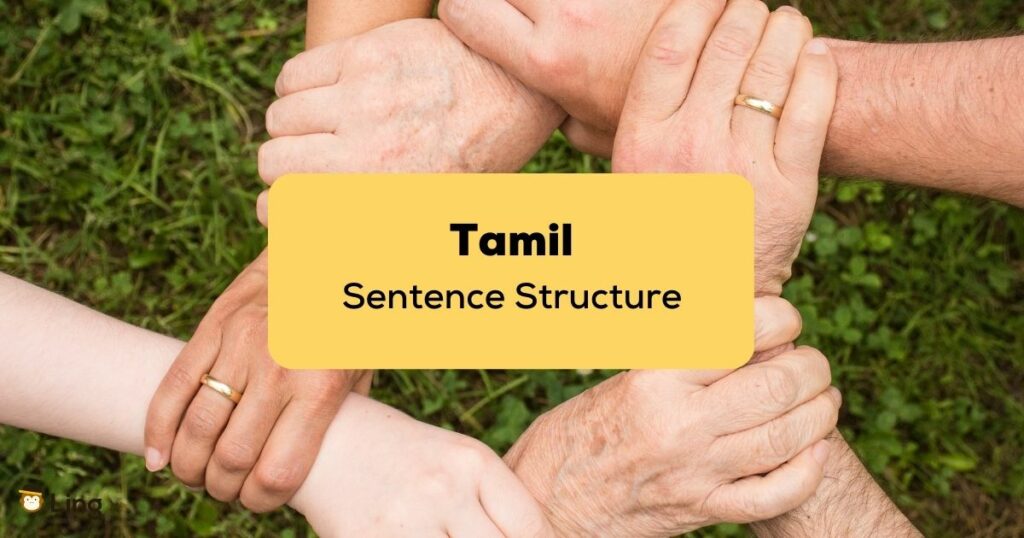The Tamil language and modern Tamil have specific sentence structures. But it is important to note that not all Tamil sentences follow a structure. Spoken Tamil may not always follow them. In Tamil script though, people tend to be more constructive and formal. Let’s look at the Tamil sentence structure and understand it better!
We know that Tamil is the official language of Tamil Nadu, a state in southern India. The grammar and language go back up to 300 BC. It was called the தொல்காப்பியம் Tolkappiyam. Classical Tamil is in fact a really big deal as it is one of the oldest and active languages. The Tamil alphabet is also very special so let’s take a look.
Modern Standard Tamil
Modern Tamil is based on நன்னூல் Nannul, the new grammar which evolved from the 13th century. The main difference between modern and old Tamil is of course the changes made in modern Tamil due to the changing of people. As the number of Tamil-speaking people grew, the language itself took a change too.
Now let’s look at how to make sentences.
Subjects Verbs And Objects

Sentence structure is the way in which words and phrases are combined to form a grammatically correct sentence. It includes the order of the subject, verb, and object, as well as the use of modifiers and other grammatical elements.
In Tamil, the basic sentence structure is mainly Subject-Verb only, which follows a verb-final word order. That’s right! An object is not always necessary. Word order is important in Tamil since it affects the meaning of a sentence. Modifiers come after the word they modify, and adverbs come before the verb.
When talking about this, Tamil verbs are really important. A sentence undergoes a sentence construction that involves a beginning middle and end. The job of auxiliary verbs is to support the main verb. So, we can call it a helping verb.
To start, here are some words that are often the subject of a sentence in Tamil. It is usually a noun or a pronoun.
| English | Tamil | Pronunciation |
| I | நான் | Nan |
| You | நீங்கள் | Ninkal |
| He | அவர் | Avar |
| She | அவள் | Aval |
| It | அது | Atu |
| They | அவர்கள் | Avarkal |
| We | நாங்கள் | Nankal |
Here are some Tamil verbs. Each of the verbs is from a root word. Using a verb stem, it is conjugated and used in a sentence.
| English | Tamil | Pronunciation |
| Come | வா | Saa |
| Eat | சாப்பிடு | Saapidu |
| Laugh | சிரி | Siri |
| Go | போ | Po |
| Walk | நட | Nada |
Objects can again be nouns, pronouns, noun clauses, noun phrases, and so on. They are what the subject and verb are talking about. But as mentioned before, a subject and verb are enough to make sense in Tamil, and objects are not always needed.
Tamil Sentence Structure

Before we get into the Tamil sentence structure, we need to understand what is a subject-object-verb combination.
There are certain steps to follow when creating a sentence in the Tamil language. In this language, a lot of words are derived from a root word and are changed using suffixes. So firstly, choose the root words and suffixes that you need to create the sentence. Then, determine the verb tense you need to use.
Next, choose the appropriate inflections for the nouns, pronouns, and adjectives. Place the words in the correct order to form a sentence. Then, use the appropriate conjunctions and particles to join the words. Finally, check your sentence for accuracy.
In English, sentences typically follow a Subject-Verb-Object structure, which means that the subject of the sentence is placed first, followed by the verb, and then the object. In Tamil, following the subject-verb structure, let’s look at the same sentence. For example: நாய் குரைத்தது. Nāy kuraittatu (The dog barked). Just two words!
Here are some sentences using Tamil sentence structure.
| English | Tamil | Pronunciation |
| I walk to school. | நான் பள்ளிக்கு நடந்து செல்கிறேன் | Paḷḷikku nāṉ naṭantu celvēṉ. |
| He has three sons. | அவருக்கு மூன்று மகன்கள் | Avarukku mūṉṟu makaṉkaḷ. |
| Tom runs very fast. | டாம் ரொம்ப வேகமாக ஓடுகிறான் | Ṭām mika vēkamāka ōṭukiṟāṉ. |
| He likes to run. | அவன் ஓட விருப்பப் படுகிறான் | Avar ōṭa virumpukiṟār. |
| This apple is sweet. | இந்த ஆப்பிள் இனிப்பாக இருக்கிறது | Inta āppiḷ iṉippu. |
| We swam in the lake. | அவன் ஏரியில் நீச்சலடித்தான் | Nāṅkaḷ ēriyil nīntiṉōm. |
| We ran after the thief. | நாங்கள் திருடனுக்குப் பின்னால் ஓடினோம் | Nāṅkaḷ tiruṭaṉaip piṉtoṭarntu ōṭiṉōm. |
| This CD belongs to her. | இந்த சீடி அவளுக்குச் சொந்தமானது | Inta ciṭi avaḷukku contamāṉatu. |
| He painted a picture of a dog. | ஒரு நாயின் படத்தை வரைந்தான் | Avar oru nāyiṉ paṭattai varaintār. |
Funny Things About Tamils
If you are interested in their sentence structure, you probably would like to know more about the Tamils. They LOVE their filter coffee. They never forget to take their tiffin box to work or anywhere. Having homemade lunch boxes is very much part of the culture.
They are very competitive and always want to win at everything. They love their spices and are known to be spice connoisseurs. They love their movies and can quote dialogues from any movie. They love their family and friends and will always be there to help them, especially at weddings.
Learn Tamil With Ling

The vastness of the Tamil language, grammar, and culture can easily throw off anyone. Tamil Nadu is also a great idea for any traveler looking for a unique cultural and scenic experience. The state is home to India’s most beautiful landscapes.
Visitors can explore the ancient temples and monuments of the region, as well as enjoy its vibrant music, art, and cuisine. Tamil Nadu is also home to some of India’s most beautiful beaches, wildlife sanctuaries, and hill stations.
To help you in your journey to understanding Tamil sentence structure, partner with the Ling App. It can be used to learn Tamil by providing interactive lessons and quizzes to help users learn the language. The app also offers audio recordings of native Tamil speakers to help users with pronunciation and listening comprehension. It also has a built-in dictionary and flashcards to facilitate vocabulary learning.
Find us on the Apple Store or Google Play Store today and start a quest of a lifetime!



































































